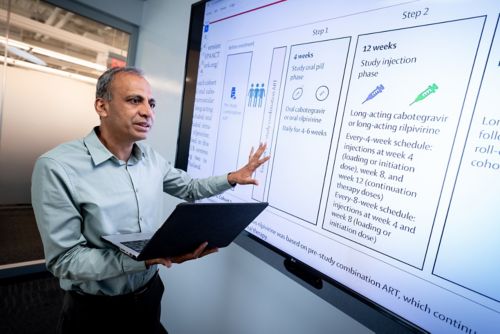St. Jude Family of Websites
Explore our cutting edge research, world-class patient care, career opportunities and more.
St. Jude Children's Research Hospital Home

- Fundraising
St. Jude Family of Websites
Explore our cutting edge research, world-class patient care, career opportunities and more.
St. Jude Children's Research Hospital Home

- Fundraising
Long-acting injectable HIV drugs safe for treating adolescents

Aditya Gaur, MD, St. Jude Division of HIV Medicine director who co-led the clinical trial for long-lasting HIV injections.
When a person is infected with human immunodeficiency virus (HIV), the virus’s genome integrates into that person’s DNA, making it a part of them for life. While there is no scalable cure yet, HIV can be treated effectively. On the heels of decades of laboratory and clinical research, pharmaceutical chemists have created novel drugs that suppress the virus. These drugs have been game-changing, increasing life expectancy by decades and significantly improving the quality of life for people living with HIV.
Though modern HIV suppression drugs are effective, they must be taken daily. Taking medication consistently daily for any chronic disease, including diabetes and hypertension, can be hard for anyone. Add in the stigma associated with medications for a person living with HIV, and adherence to medications can be even more challenging. This, in part, has prompted the push to make long-acting, novel formulations of medications for HIV treatment and prevention: medications that can be dosed every four or eight weeks and given as injections. Because the drugs don’t need to be taken daily, the likelihood of missing a dose also decreases.
When new medications are developed, they are typically tested first in adult patients, and only once approved are they then tested in children and adolescents. In adults, drugs called cabotegravir and rilpivirine were among the first to be approved as a pair for long-lasting HIV treatment. While drugs showing safety and efficacy in adults suggest they will also work in children and adolescents, it still needs to be confirmed and dosing and safety for these age groups established. Therefore, a multinational National Institutes of Health (NIH)-funded International Maternal Pediatric Adolescent AIDS Clinical Trials (IMPAACT) Network clinical trial, co-led by Aditya Gaur, MD, St. Jude Division of HIV Medicine director and Carolyn Bolton-Moore, from the Centre for Infectious Disease Research in Zambia, was conducted. The study’s primary goal was to determine the safety of these medicines and drug exposure in adolescents aged 12 to 18. The positive findings from the first cohort of study participants were published recently in two companion manuscripts in The Lancet HIV. This IMPAACT 2017 study, also referred to as the More Options for Children and Adolescents (MOCHA) study, is supported by the NIH and is in collaboration with ViiV Healthcare and Janssen R & D.
“The papers report findings from the first group of adolescents in the world to receive these two injectables separately in addition to the oral HIV treatment they were receiving,” Gaur said. “We looked to see if there were any surprises in terms of side effects or drug exposures compared to what has been seen in adults. Was there an unexpected safety signal? And the answer was no. Was the adult dose reasonable to use down to age 12 and/or 35 kgs in weight? And the answer was yes.”
Adolescent patients with HIV showed no serious adverse effects of receiving the treatment. For the initial part of the study (Cohort 1), the study participants from the United States, Botswana, South Africa and Thailand continued their normal daily pill for HIV treatment, which typically includes three different medications, but also received two to three injections of one of the two long-acting drugs (cabotegravir or rilpivirine), intramuscular, four weeks apart.
An interim analysis shows these drugs appeared as effective in adolescents as adults living with HIV. In addition, there were no new safety concerns. That interim report informed the approval of this combination of long-acting medications given every four weeks or eight weeks in virologically suppressed adolescents aged 12 years and older and weighing at least 35 kilograms by the U.S. Food and Drug Administration (FDA) and Canada Health.
St. Jude continues its history of contributing to HIV research milestones
“What’s most exciting to be part of a study that made the milestone of having the first long-acting, all-injectable treatment regimen for HIV possible for adolescents,” Gaur said. “A few decades from now, we will reflect and say this was another milestone in how we addressed the management of HIV, similar to the discovery of the first oral combination HIV treatment, sometimes referred to as the HIV drug cocktail and then its co-formulations into a one pill, once a day regimen. Long-acting HIV treatment adds yet another treatment option for people living with HIV.”
St. Jude has been involved in treating patients with HIV since its initial recognition in the 1980s. Generations of physicians and scientists have dedicated their careers to both frontline care and improving therapeutic options from the very beginning.
“Historically, and with credit to the vision of Dr. Walter Hughes and the institution’s founder, Danny Thomas, St. Jude has had a formal program focused on clinical care and research in HIV treatment and prevention dating back to 1987,” Gaur explained. “This study continues that legacy of contributions to HIV clinical research.”
Accelerating HIV drug translation from adults to adolescents
“There will always be a little bit of lag between when promising drugs or discoveries get approved for adults versus adolescents and kids,” Gaur explained. “But for this first, all injectable HIV treatment regimen of long-acting cabotegravir plus rilpivirine, approval for use for adolescents in USA and Canada was relatively soon after the approval for adults and is in large part credit to the IMPAACT 2017 study participants and the collaboration between the NIH, ViiV Healthcare and Janssen R & D.”
The FDA first approved this two-drug, injectable treatment regimen for treatment of adults with well-controlled HIV in January 2021 and then, informed by the interim analysis results from IMPAACT 2017, approved for adolescents between ages 12 to 18, weighing at least 35 kg, with well-controlled HIV in March 2022.
The study is continuing into a phase 2 trial, where patients stop taking the daily pill and are solely on the once-every-two-months injectable HIV treatment regimen. The information from that part of the trial will inform regulatory applications worldwide, including with the European Medical Authorization.
“At an individual level,” Gaur concluded. “It’s most rewarding to hear the testimonies of the adolescents who shared what it meant for them not to have to take daily oral medications and to experience some relief from the feeling of stigma.”






